This easy lemon semolina cake is a perfect treat for all the citrus lovers out there. With incredibly soft and tender crumb, zesty and fragrant fresh lemon flavour and beautiful appearance, this cake ticks all of the boxes!
Semolina gives this bake a very unique, light and crumbly texture, and together with heaps of the simple lemon syrup, allows the cake to stay moist for days! It is simple and quick to whip up, making it an ideal every day tea time snack.
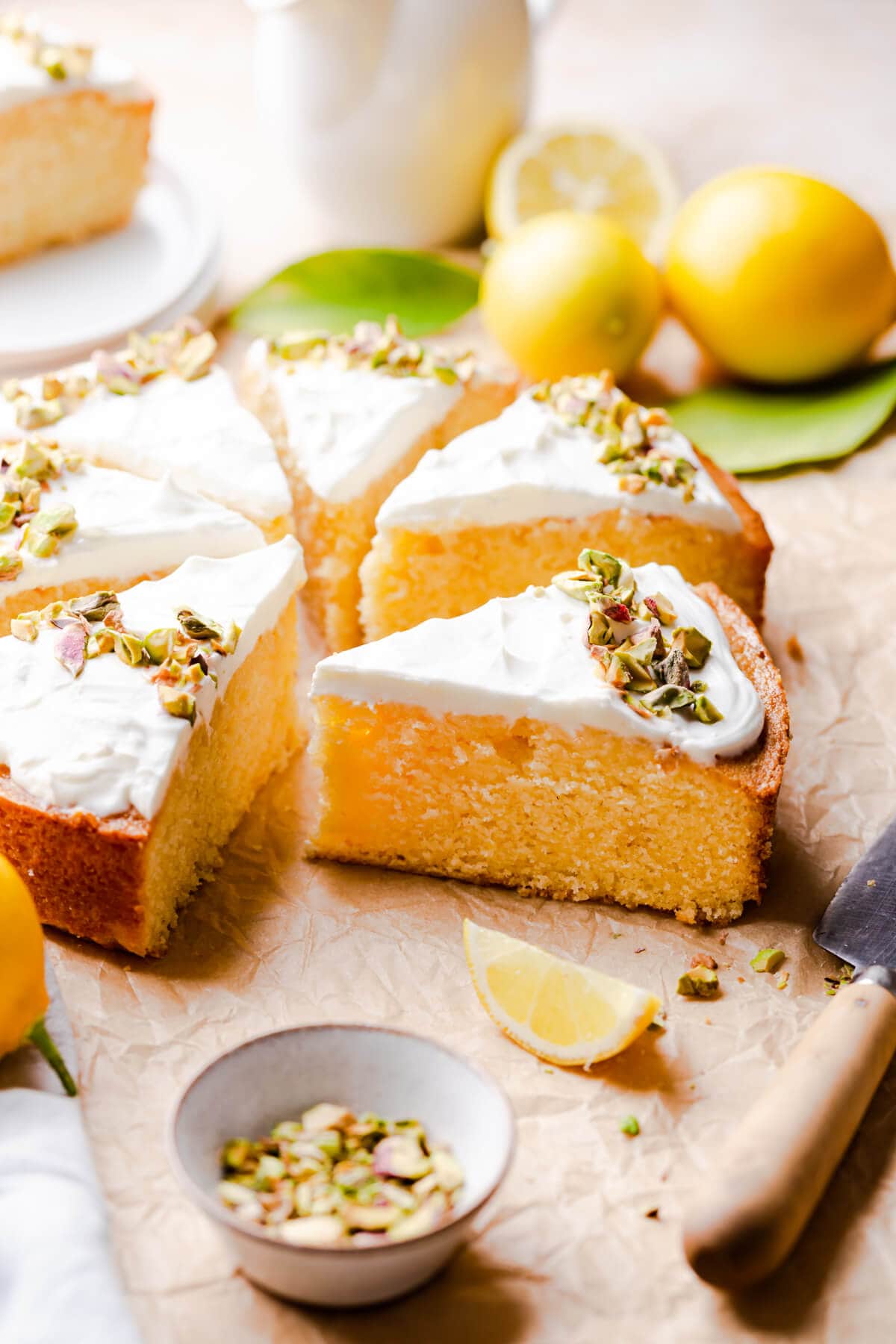
It's not a secret that I love lemon recipes, and this recipe is very similar to my Blood Orange Semolina Cakes recipe but we are using lemons instead of oranges. If you prefer a more traditional citrus bake, without the semolina, you may like this Zesty Lemon Cake recipe or my Small Batch Lemon Drizzle recipe.
The sweetness of the sugar syrup balances really well with the topping of Greek yoghurt, but you can also enjoy this cake plain, without the topping. Either way, it will be delicious!
Jump to:
Ingredients
Here's what you will need to make this lemon semolina cake:
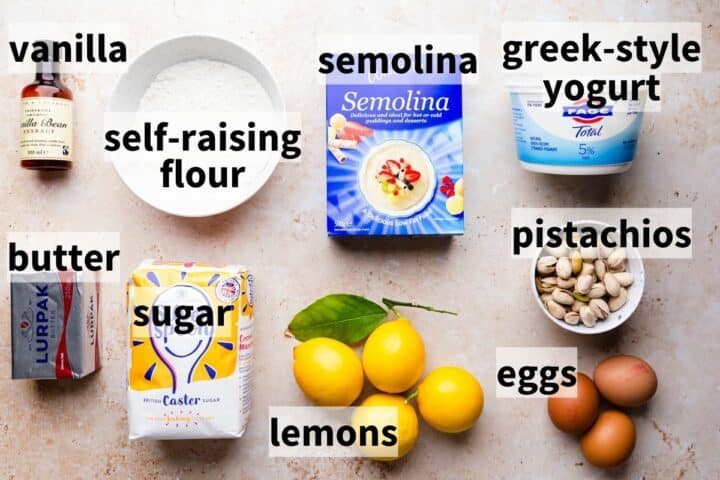
- Flour - This recipe calls for self-raising flour.
- Semolina - It's what gives this lemon cake a unique texture. You can use fine or coarse semolina in this recipe. If using coarse semolina, which is more gritty, you may want to use the blender to grind it ever so slightly into finer texture.
- Sugar - White caster or granulated sugar will work best.
- Butter - I prefer to use unsalted butter in my bakes, but salted butter is also fine.
- Lemons - Use fresh, unwaxed lemons for best results.
- Vanilla - Vanilla extract is not necessary, but great for adding an extra flavour.
- Full fat Greek-style yogurt - Optional ingredient. Yogurt works great as a topping for this cake, as it balances out the sweetness.
- Pistachios - Another optional ingredient. Pistachio nuts will add an extra texture and a lovely pop of colour.
See recipe card below for a full list of ingredients and measurements.
Substitutions and Variations
- Swap self-raising flour for plain / all purpose flour (same amount), but add 1 and ½ teaspoon of baking powder to the dry ingredients.
- If you don't want to use lemons, feel free to use oranges instead. Any type of citrus will actually work really well, so feel free to use your favourite type or even a mixture of different citrus fruits.
- For a vegan version of similar cake, check out this Vegan Semolina Cake recipe from Domestic Gothess website.
- Use whipped cream instead of yogurt to top the cake with. You can also leave it plain. Adding some candied lemon slices on top could be a nice way to decorate the plain cake.
- This cake batter can be used to bake mini lemon semolina cakes or cupcakes. Simply divide the batter between the cupcake liners and bake for about 15 minutes, or until toothpick inserted in the middle comes out clean.
Instructions
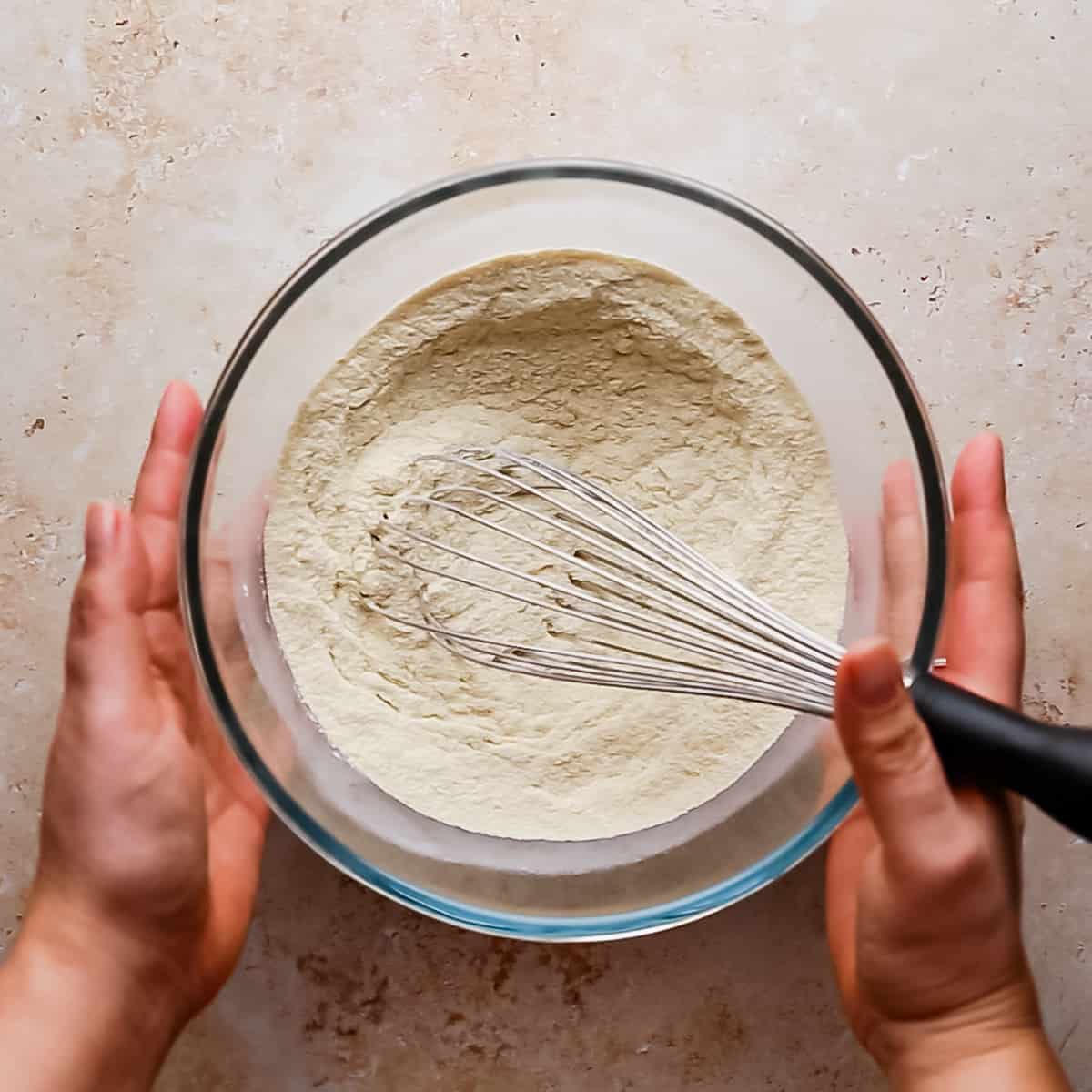
Combine the flour, semolina and a pinch of salt in a mixing bowl. In a small jug, mix the lemon zest, lemon juice and vanilla, and set aside.

In a separate bowl cream the softened butter and sugar together, then add eggs, one at a time, whisking well after each addition.
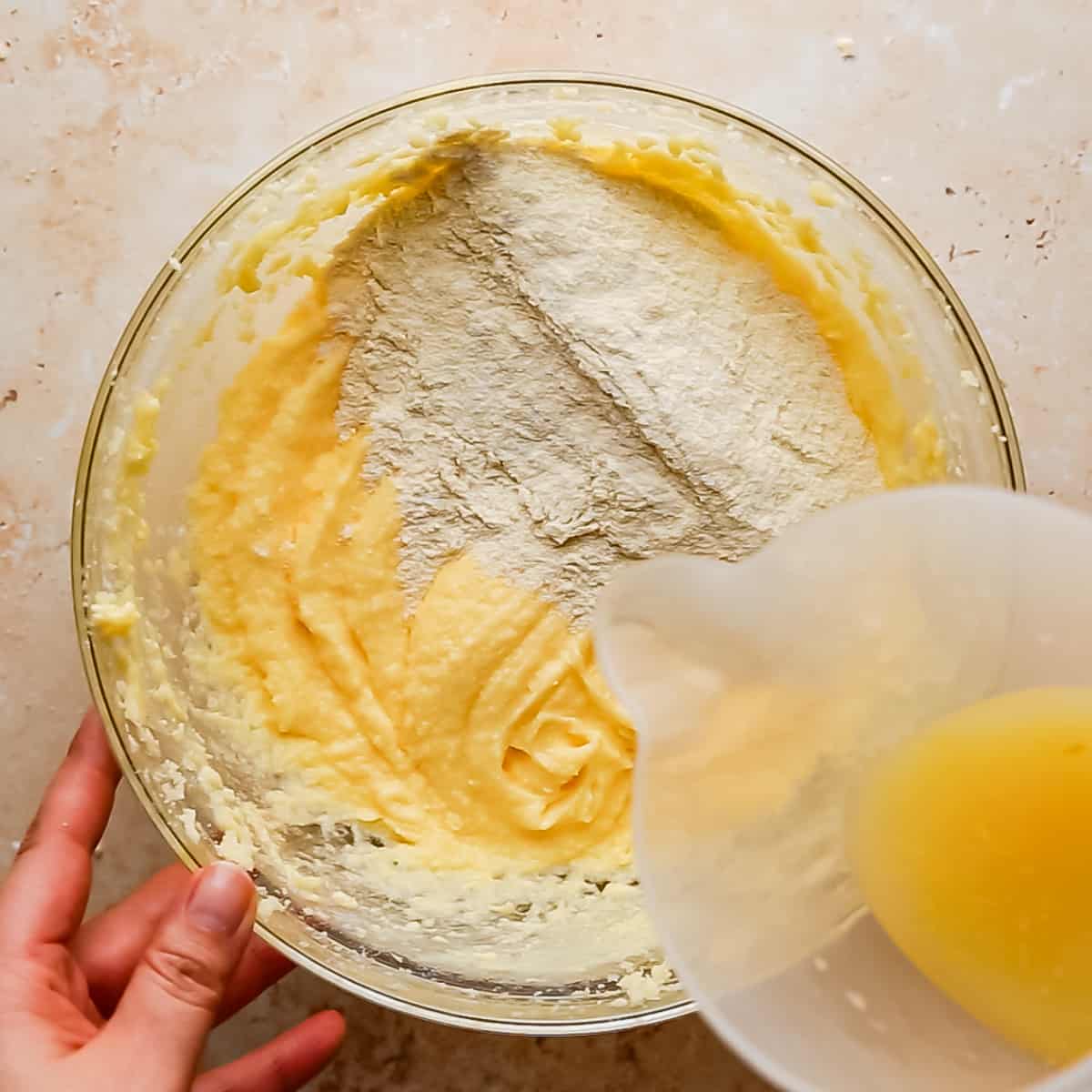
Tip half of the flour and semolina mixture into the egg and butter mixture, followed by half of the lemon juice. Fold gently to combine, then add the remaining flour and lemon juice and fold again until just combined.
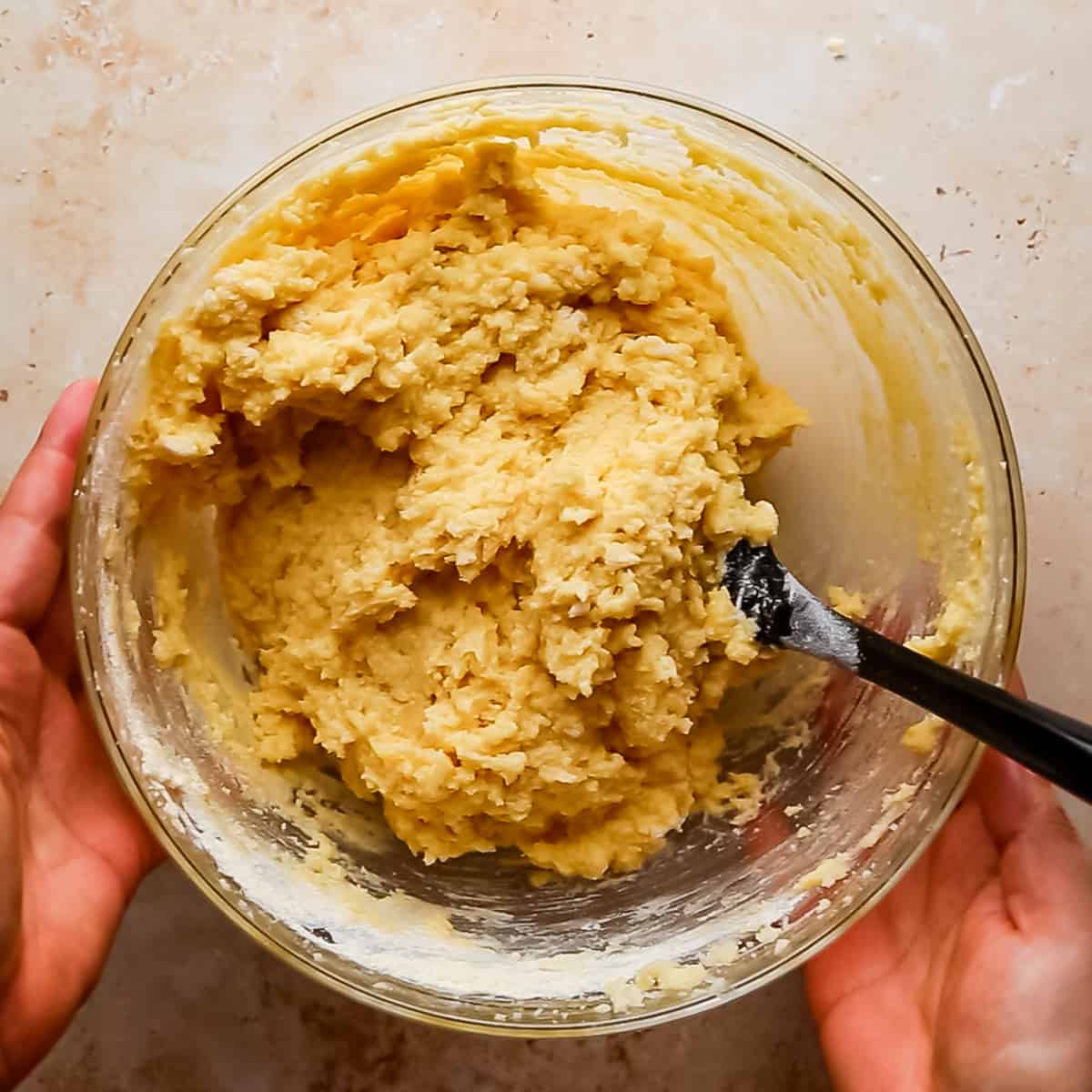
Transfer the cake batter into the prepared baking tin and smooth the top with offset spatula or the back of a spoon and bake for 40- 45 minutes.
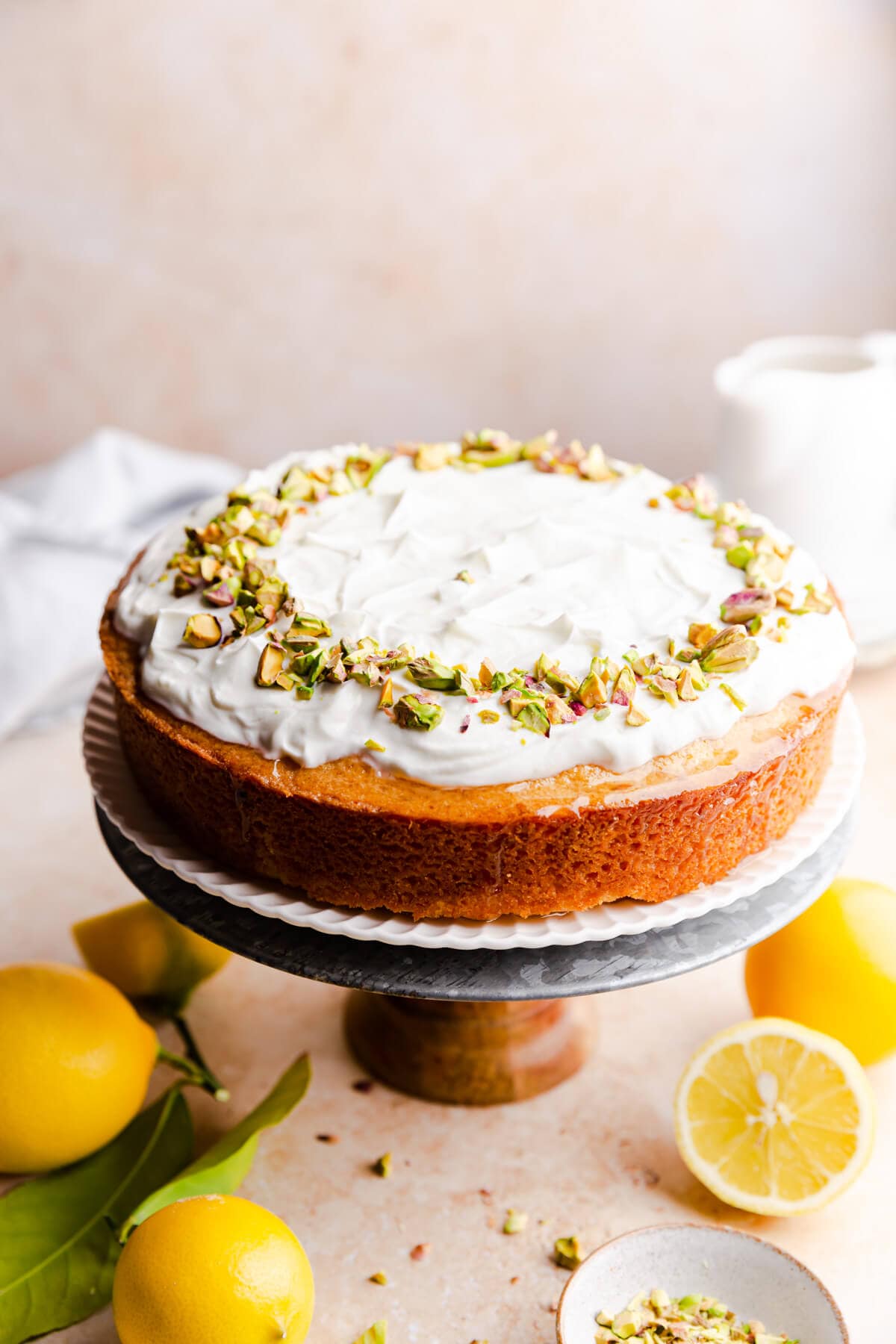
Allow the cake to cool completely, before drizzling it with the lemon sugar syrup and topping it up with Greek yogurt. Cut into slices and enjoy!
Serving suggestion: Make the lemon sugar syrup, allow it to cool down to room temperature, then pour it over cooled cake. Allow the syrup to absorb into the cake for about 30 minutes, then proceed to topping it up with yoghurt and pistachios.
Alternatively, you can serve lemon cake plain, without the yogurt topping. If you keep this cake plain, you could serve it hot or warm with a drizzle of custard or a scoop of ice cream on side!
Storage
Lemon semolina cake keeps really well, and stays moist and spongy for days. Store any leftovers in the airtight container in the fridge for up to 3 days (for the cake with the yoghurt topping).
Plain cake (without the yogurt) can be stored in the airtight container at room temperature for up to 5-6 days.
This cake is also suitable for freezing (plain, without the syrup or yoghurt topping). Make sure not to pour the simple syrup over the cake before freezing it. If you soak the cake in syrup and try to freeze it, the syrup will form ice crystals and this can allow the freezer burn to set up.
To freeze, wrap the cooled cake in a double layer of clingfilm and place it in the freezer for up to 3 months. Thaw it in the fridge overnight. Poke it with the skewer or with a fork, and soak in the syrup about 30 minutes before serving it.

Top Tips
- This cake was tested in the 20 cm (8 inch) loose-base cake tin, which is 5 cm (2 inch) tall, and it fits this cake perfectly. You can also use 20 cm square baking tin, or a larger round cake tin (the cake won't be as high and you will have to adjust the baking times accordingly).
- Don't worry if your cake batter mixture splits or curdles a bit. It will all come together when cake bakes.
- If your cake happens to have a little indent or dip in the centre once baked, do not allow the sugar syrup to sit there for too long. This would cause the cake to collapse and it will become soggy. Brush the syrup from the middle part of the cake equally over its surface.
- Use up any leftover lemon zest and lemon juice in another recipe, like these easy and delicious Lemon Cookies.
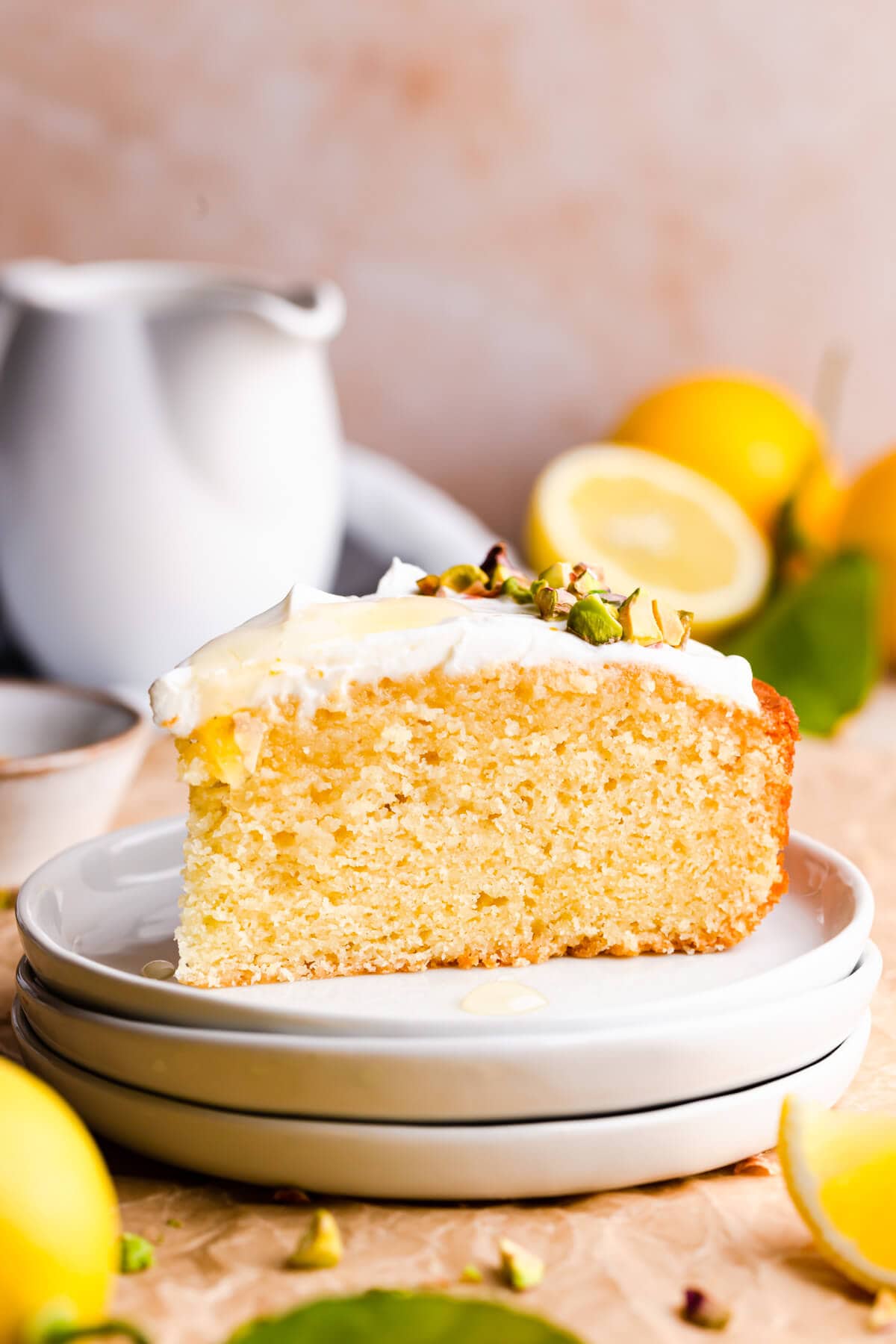
Frequently Asked Questions
Semolina adds subtle sweetness and nutty flavour to bakes. You don't have to use it, and you could just substitute semolina for self-raising or plain flour, but the texture and the taste of the cake will not be the same.
Semolina refers to meal or flour made from durum wheat, using specific grinding methods. You may find coarse, medium or finely grated semolina in the shops, and different manufacturers may label it differently. Most of the semolina sold in the UK shops is fine semolina, which is much softer and silkier in texture than coarse type (more gritty).
Fine semolina is almost as fine in texture as regular wheat flour. Some producers may label fine semolina as semolina flour. But that isn't always correct. Semola (or semolina flour) is even finer in texture and is used to make pastas, pizzas and breads.
This could be caused by adding the syrup that was too hot, or not allowing the cake to cool down enough, before adding the syrup. Make sure to cool the cake completely, and allow the lemon syrup to cool down to room temperature before using it.
More Recipes You'll Love
Did you try this recipe? Leave a ⭐️⭐️⭐️⭐️⭐️ rating below and tag @anna_wierzbinska on Instagram!
📖 Recipe
Lemon Semolina Cake
Equipment
- 20 cm ( 8 inch) loose-base round or square cake tin
- baking paper
- hand-held electric mixer or freestanding mixer with the paddle attachment
- 2 large mixing bowls
- small saucepan
Ingredients
For the cake:
- 150 g self- raising flour see notes for the alternative
- 150 g semolina
- ½ teaspoon salt
- 2 medium lemons zest only
- 100 ml lemon juice (about 3 medium lemons)
- 1 teaspoon vanilla extract
- 250 g sugar caster or granulated
- 250 g butter softened
- 3 large eggs
- 150 g full fat Greek style yogurt optional
- 40 g unsalted pistachios, roughly chopped optional
For the lemon syrup:
- 100 g sugar caster or granulated
- 100 ml lemon juice (about 3 medium lemons)
Instructions
To make the cake:
- Preheat oven to 180°C (160°C fan). Grease the 20 cm loose-base cake tin and line the bottom of it with the baking paper. Set aside.
- In a medium bowl, whisk together the flour, semolina and salt. In a small jug or a small bowl, combine the zest of two lemons, 100 ml of lemon juice and the vanilla.150 g self- raising flour, 150 g semolina, ½ teaspoon salt, 2 medium lemons, 100 ml lemon juice, 1 teaspoon vanilla extract
- Using an electric mixer, cream together the softened butter and sugar until you have pale and fluffy mixture. This should take about 2-3 minutes. Add eggs, one at a time, whisking well after each addition and scraping the bowl when needed.250 g sugar, 250 g butter, 3 large eggs
- Tip half of the flour mixture into the eggs and sugar, followed by half of the lemon juice mix. Fold gently to combine, then add the remaining flour and lemon juice, and fold again, until just combined. Transfer the batter into the prepared cake tin, smoothing the top with an offset spatula or the back of a spoon.
- Bake the cake for 40- 45 minutes, or until toothpick inserted in the middle comes out clean. Remove from the oven and allow the cake to cool completely.
To make the lemon syrup:
- Place the sugar and lemon juice into a small saucepan over a medium heat. Allow the sugar to dissolve completely, and simmer until the mixture reduced in half (about 3 minutes). Take off the heat and allow the syrup to cool down to room temperature.100 g sugar, 100 ml lemon juice
- When the cake is cool, poke its surface with the skewer or with a fork. Pour half of the lemon syrup over the top of the cake ( use the pastry or silicone brush to spread the syrup over the top surface of the cake if needed), and allow it to soak in for about 30 minutes. Save the remaining lemon syrup for serving.
- Top the cake with Greek yogurt and chopped pistachios (optional). Slice and enjoy!150 g full fat Greek style yogurt, 40 g unsalted pistachios, roughly chopped
Please note that all my recipes are developed and tested in metric grams. I recommend that you use digital scales for a more accurate results. I have provided a conversion to US customary in the recipe but please note that I haven’t tested using this method.
Video
Notes
- You can use oranges instead of lemons, or even a mixture of both.
- Allow the cake to cool down completely before drizzling it with the lemon syrup.







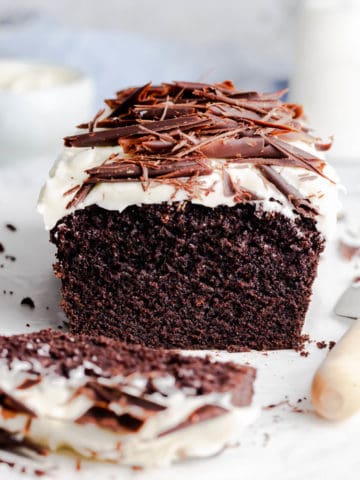
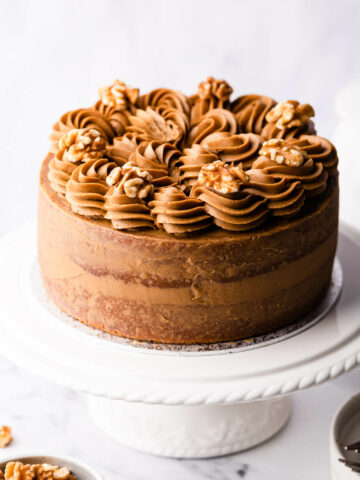

Jenny
This was my fourth lemon cake recipe in a row, I have been trying to find the best lemon cake because my daughter loves it. Yours won by a mile. I loved using the semolina flour. Great flavor, super lovely texture. Thank you!
Laura Arteaga
I'm not good at baking, but this recipe was extremely easy to follow and the cake came out perfect. My family was very surprised! Will try cooking with semolina more often!
mik
We loved the cake, though I admit we did not frost it, just drizzled the lemon syrup over it and cut in. It was so delicious!
DK Park
Honestly, this is my first time making a semolina cake. I thought that it was hard but I had a great time making this. It is so easy, pretty, and delicious. For me, this is one of the best Valentine's desserts to make.
Leslie
This lemon syrup my favorite thing about this recipe! It's the perfect addition to this amazing cake!
Enriqueta E Lemoine
This cake is to die for! I love everything citrusy, and this semolina cake has all I want! The texture is perfectly dense. I made it without the yogurt topping and I'm dreaming of making it again. Thanks for the recipe and the inspiration.
Maya
I've been looking for a good semolina cake recipe for a while (weirdly specific, I know) because I had an amazing one at a bakery in London last summer and have been attempting to reproduce it. This one is delicious! I think the addition of the yogurt and letting the syrup soak really helps.